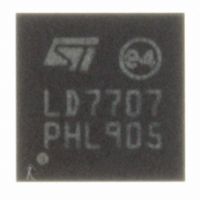LED7707TR STMicroelectronics, LED7707TR Datasheet - Page 25

LED7707TR
Manufacturer Part Number
LED7707TR
Description
IC LED DRIVR WHT BCKLT 24-VFQFPN
Manufacturer
STMicroelectronics
Type
Backlight, White LEDr
Datasheet
1.LED7707TR.pdf
(47 pages)
Specifications of LED7707TR
Topology
PWM, Step-Up (Boost)
Number Of Outputs
6
Internal Driver
Yes
Type - Primary
Backlight
Type - Secondary
White LED
Frequency
250kHz ~ 1MHz
Voltage - Supply
4.5 V ~ 36 V
Voltage - Output
36V
Mounting Type
Surface Mount
Package / Case
24-VFQFN, 24-VFQFPN
Operating Temperature
0°C ~ 85°C
Current - Output / Channel
85mA
Internal Switch(s)
Yes
High Level Output Current
85 mA
Operating Supply Voltage
4.5 V to 36 V
Maximum Supply Current
1 mA
Maximum Power Dissipation
2.3 W
Maximum Operating Temperature
+ 150 C
Mounting Style
SMD/SMT
Minimum Operating Temperature
- 40 C
For Use With
497-10044 - BOARD EVAL LCD BACKLIGHT LED7707
Lead Free Status / RoHS Status
Lead free / RoHS Compliant
Efficiency
-
Lead Free Status / Rohs Status
Details
Other names
497-8492-2
Available stocks
Company
Part Number
Manufacturer
Quantity
Price
Company:
Part Number:
LED7707TR
Manufacturer:
ST
Quantity:
12 000
Company:
Part Number:
LED7707TR
Manufacturer:
STMicroelectronics
Quantity:
10 000
LED7707
6
6.1
6.1.1
Application information
System stability
The boost section of the LED7707 is a fixed frequency, current-mode converter. During
normal operation, a minimum voltage selection circuit compares all the voltage drops across
the active current generators and provides the minimum one to the error amplifier. The
output voltage of the error amplifier determines the inductor peak current in order to keep its
inverting input equal to the reference voltage (700 mV typ). The compensation network
consists of a simple RC series (R
The calculation of R
dynamic performance of the boost converter and is strictly related to the operating
conditions.
Loop compensation
The compensation network can be quickly calculated using equations 11 to 16. Once both
R
get the optimal dynamic performance from the application.
The first parameter to be fixed is the switching frequency. Normally, a high switching
frequency allows reducing the size of the inductor and positively affects the dynamic
response of the converter (wider bandwidth) but increases the switching losses. For most of
applications, the fixed value (660 kHz) represents a good trade-off between power
dissipation and dynamic response, allowing to save an external resistor at the same time. In
low-profile applications, the inductor value is often kept low to reduce the number of turns;
an inductor value in the 4.7 µH-15 µH range is a good starting choice.
In order to avoid instability due to interaction between the DC-DC converter's loop and the
current generators' loop, the bandwidth of the boost should not exceed the bandwidth of the
current generators. A unity-gain frequency (f
take care not to exceed the CCM-mode right half-plane zero (RHPZ).
Equation 11
Equation 12
Equation 13 a
COMP
and C
COMP
have been determined, a fine-tuning phase may be required in order to
COMP
and C
f
U
≤
0
2 .
COMP
COMP
⋅
2
M
⋅ π
2
is fundamental to achieve optimal loop stability and
R
L
- C
f
U
M =
=
≤
COMP
0
0
U
2 .
V
2 .
) in the order of 30-40 kHz is acceptable. Also,
V
IN
⋅
OUT
⋅
⎛
⎜
⎜
⎝
,
) between the COMP pin and ground.
F
min
V
V
SW
IN
OUT
,
min
2
⋅ π
⎞
⎟
⎟
⎠
2
⎛
⎜
⎜
⎝
L
V
I
OUT
OUT
⎞
⎟
⎟
⎠
Application information
25/47





















